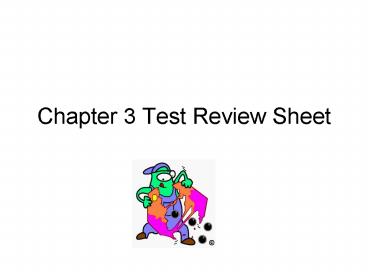Chapter 3 Test Review Sheet PowerPoint PPT Presentation
1 / 42
Title: Chapter 3 Test Review Sheet
1
Chapter 3 Test Review Sheet
2
1
- What functional groups are these
- -OH -COOH -CO -NH2 -OPO3-
- ANSWERhydroxyl carboxyl carbonyl amino
- phosphate
3
1 (cont.)
- What functional groups are these?
- -SH -CO (and end) -CO (within)
- Sulfhydryl aldehyde ketone
4
2
- What are the monomers of these polymers?
- Proteins nucleic acids carbos lipids
- ANSWER
- Amino acids nucleotides
monosaccharides glycerol 3 fatty acids
5
3
- How can you tell the difference between a
saturated fat, a monounsaturated fat, and a
polyunsaturated fat when shown the chemical
structure? - ANSWER saturated fat has all single bonds,
unsaturated fat has at least one double bond,
polyunsaturated fat has 2 or more double bonds
6
4
- How are isomers related?
- ANSWER isomersame atomic structure but
different orientation
7
5
- Contrast dehydration synthesis and hydrolysis
Purpose? How alike? How different? - ANSWERDehydration synthesis-takes out water to
join monomers - Hydrolysis-adds water to split polymers
8
6
- What suffix do sugars end in? Examples
- ANSWER -ose
- Monosaccharide glucose, fructose
- Disaccharide sucrose, maltose
- Polysaccharide starch, glycogen
9
7
- How is glycogen different than starch?How are
they alike? - ANSWER glycogen is formed in animals and starch
is formed in plants they both are
polysaccharides of glucose
10
8
- How is a positive test done for each?Glucose
starch fats protein - ANSWER
- Glucose- Benedicts blue to orange-red
- Starch-iodine yellow to blue-black
- Fats-translucent brown paper
- Protein- Biuret blue to lavender
11
9
- What is the purpose of cellulose? Type of carbo?
- ANSWER fiber
- polysaccharide
12
10
- What does hydrophilic and hydrophobic mean?
Which best describes fats? - ANSWER hydrophilic (does dissolve in water) and
hydrophobic (does not dissolve in water) FATS
ARE HYDROPHOBIC - -methyl group CH3 is hydrophobic
13
11
- Polypeptide and amino acid chains are synonyms
for what macromolecule? - ANSWER protein
14
12
- How could you tell the difference between a
monosaccharide and a disaccharide if shown the
chemical structure? - ANSWERmonosaccharide 1 ring
- Disaccharide 2 rings
15
13
- How does a steroid look different chemically than
other lipids? - ANSWER 4 rings
16
14
- What are the parts of a triglyceride? How many
water molecules are formed from the formation of
it? - ANSWER 3 fatty acids a glycerol
- Three water molecules form when they join.
17
15
- Rectangle around polar end
- Circle around nonpolar end
18
15
- Rectangle around polar end
- Circle around nonpolar end
19
16
- Identify the following as
- C-carbohydrate P-protein
- L-lipid NA-nucleic acid
- _____DNA_____glucose
- _____steroid
- _____phospholipid
20
16
- Identify the following as
- C-carbohydrate P-protein
- L-lipid NA-nucleic acid
- NA DNA C glucose
- L steroid
- L phospholipid
21
16
- Identify the following as
- C-carbohydrate P-protein
- L-lipid NA-nucleic acid
- _____wax
- _____starch
- _____ATP
- _____RNA
22
16
- Identify the following as
- C-carbohydrate P-protein
- L-lipid NA-nucleic acid
- L wax
- C starch
- none of above ATP
- NA RNA
23
16
- Identify the following as
- C-carbohydrate P-protein
- L-lipid NA-nucleic acid
- _____sucrose
- _____enzymes
- _____fructose
- _____triglyceride
24
16
- Identify the following as
- C-carbohydrate P-protein
- L-lipid NA-nucleic acid
- C sucrose
- P enzymes
- C fructose
- L triglyceride
25
16
- Identify the following as
- C-carbohydrate P-protein
- L-lipid NA-nucleic acid
- _____ethanol
- _____formaldehyde
- _____cholesterol
- _____egg white
26
16
- Identify the following as
- C-carbohydrate P-protein
- L-lipid NA-nucleic acid
- C ethanol
- C formaldehyde
- L cholesterol
- P egg white
27
17
- How can you tell carbohydrates and lipids apart?
- Carbohydrates HO
- 21
- Lipids greater than 21
28
18
- What is the functional group found in alcohols?
What suffix denotes an alcohol? - -OH
- -ol such as ethanol, butanol
29
19
- How many different amino acids are there?
- ANSWER 20
30
19 (cont.)
- How are all amino acids alike?
31
19 cont.
- How are amino acids different?
32
20
- What does a peptide bond connect? (what
functional groups) - ANSWER amino acids
- Peptide bonds are covalent
33
21
- What is denaturation. To which macromolecule does
it refer? - ANSWER Polypeptide chain unravels, losing their
shape, and losing their function
34
22
- What type of bonds form at each level
- A. between amino acids
- ANSWER peptides (covalent)
- B. to cause coiling or pleating
- ANSWER H-bonds
35
22 (cont.)
- C. between cysteine and cysteine in tertiary
- ANSWER -disulfide bridges
- D. between H-in OH and O in COOH (tertiary)
- ANSWER H-bonding
36
22 (cont)
- Between NH3 and O
- in ionized form of carboxyl group
- ANSWER ionic bond
37
23
- What are the two possible shapes of proteins in
the secondary level? - What are the two basic shapes of proteins in the
quaternary level? - ANSWER SECONDARY alpha helix or beta pleated
sheets - QUATERNARY fibrous and globular
38
24
- What element besides C-H-O will you find in
proteins? What functional group is this? - ANSWER N (nitrogen)
- -amino group NH2
39
25
- Main parts of nucleotide? What elements?
- CHONP
40
26
- RECOGNIZE ORGANIC MOLECULES FLASH CARDS AND
QUETIONS
41
EXTENDED RESPONSE
- How do the primary, secondary, tertiary, and
quaternary structures of proteins differ? - ANSWER primary-sequence of AA
- Secondary-helix or pleated sheets
- Tertiary-folds in on itself
- Quaternary-folded together two or more subunits
42
- Refer to your handout of the Primary-Secondary-Ter
tiary-Quaternary Levels

